When the Dust Settles

- I -
Sent home to die
T he dust never really settles in the South African gold mining town of Virginia. The small Free State municipality is surrounded by some of the world’s largest gold mines, and the dust deposits that have been left behind to shoulder the town’s borders often blow low over the ground, giving the depressingly flat horizon a foggy glow.
In just 60 years Virginia went from being a boulder with the home state of two American railway surveyors etched into its side to a bustling, prospecting settlement spreading out to the banks of the Sand River, when gold was discovered there in 1949.
By then, trains traveled regularly through the area to the country’s burgeoning gold reef, Johannesburg. Every Tuesday, two would roll into Booysens Station carrying “lying-down cases” – around 20 men riddled with tuberculosis and silicosis, sent home to the Cape and Ressano Garcia in Mozambique to die.
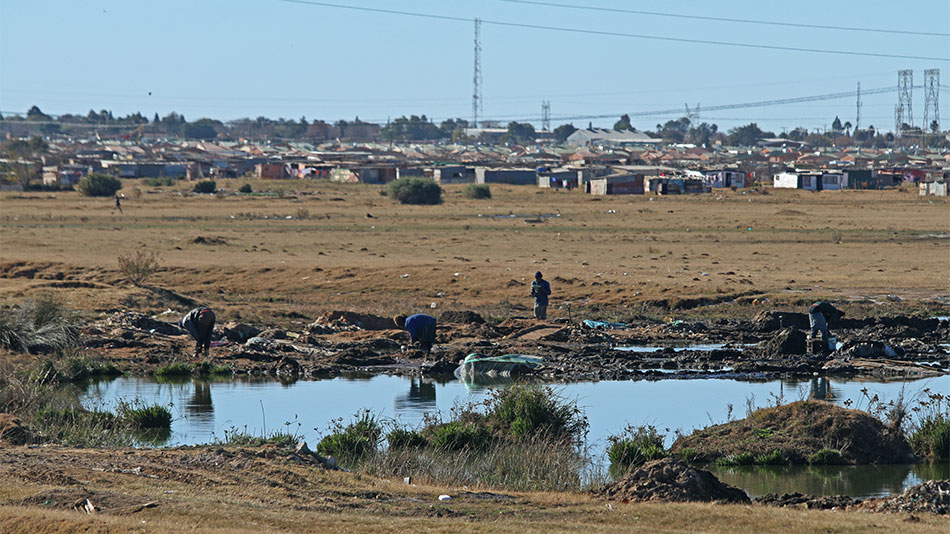
Sixty years later, the town of Virginia hasn’t substantially changed. It’s a Sunday – the third Sunday of the month. On the way to a town meeting for gold miners diagnosed with lung diseases, community volunteer Mpai Nompi reflects on how necessary these gatherings are for educating those miners still living and working in Virginia about what their forebears didn’t know, as they lay in those trains destined for Booysens Station.
That knowledge has formed the basis of a landmark class action lawsuit, brought by miner Bongani Nkala and 55 others against 32 of the world’s largest gold mining companies, including Harmony Gold, Anglo American, AngloGold Ashanti, Gold Fields, Sibanye Gold and African Rainbow Minerals. They are seeking compensation for up to half a million miners who are believed to have contracted silicosis and tuberculosis by inhaling dust while working underground.
Half a million miners have contracted silicosis & tuberculosis working underground
“Most [miners] didn’t know they were even being exposed to bad dust,” said Nompi. She’s been working with Charles Abrahams, one of the law firms representing tuberculosis sufferers in the class action suit, since 2011.
“They just want what is their due.”
In a decision handed down last year, the Supreme Court ruled that the application by the gold mine workers would be allowed to proceed against the companies, in what has been the largest class action ever certified in the country. But, while the certification comes at a crucial time, the battle is only half won, as the 32 different companies involved in the litigation seek leave to appeal; and continue to delay compensation that is already thought to be long overdue.
“There has never been a prosecution of an employer for exposing workers to harmful quantities of dust in the South African mines,” said Richard Spoor, one of the two lawyers representing the silicosis and silico-tuberculosis claimants.
Silicosis, or silico-tuberculosis, is a chronic and incurable disease that is caused by inhaling silica particles, which are created when miners blast and drill gold from rocks. Tuberculosis, which is treatable, is different from silicosis in that it can result from other external factors. But the two diseases, specifically for gold miners, tend to piggyback on one another, explained epidemiologist Rodney Ehrlich.
“They’ve known for a hundred years that silicosis and TB are strongly associated,” said Ehrlich. He’s retired now, but he spent the last 15 years running a clinic out of Cape Town’s Groote Schuur Hospital that screens ex-miners’ lungs.
“There’s no alibi for silicosis, but epidemiologically there’s no doubt that silicosis is a very strong risk factor for TB,” he said.
– –
For the past 20 years, Australian Professor of History, Jock McCulloch, has dedicated the better part of his career to understanding just how bad a deal gold miners have had over the last 100 years. He’s traveled to rural areas in Botswana, Lesotho and the Eastern Cape, gathering interviews with mine workers and medical officers about their experiences.
It was while he was conducting this research, poring over archival medical records and Chamber of Mines documents, that McCulloch began to notice a pattern emerging.
“You’ll find medical offices in rural areas in Botswana from 1920 saying that men coming back from the mines are coming back with lung disease, but they’re not being compensated,” said McCulloch on a call from Australia. He works at RMIT University in Melbourne, but makes frequent trips back to South Africa.
He described how, when black miners became noticeably ill, they would either be shipped out or repatriated, before another migrant laborer was subbed in.
This informal policy of not properly compensating black miners continued unabated and unquestioned for years. Any evidence of it was also quietly buried.
“The migrant labor system was made up of men coming from rural areas of the Eastern Cape, Botswana, Lesotho and Mozambique,” said McCulloch.
“In that time, perhaps as many as half of the former gold mine workers with silicosis have probably died”
“The men were considerably cheaper to employ than white workers, in part because of the apartheid laws.”
Despite both this overwhelming evidence and the sheer number of affected miners, lawyers representing the 32 gold mine companies have appealed the certification of the two cases since the April 2016 class action ruling. While neither Spoor nor Abrahams was surprised by these appeals, they say they are no less frustrated by the delays.
“This litigation has been going on now for 10 years and, in that time, perhaps as many as half of the former gold mine workers with silicosis have probably died,” said Spoor.
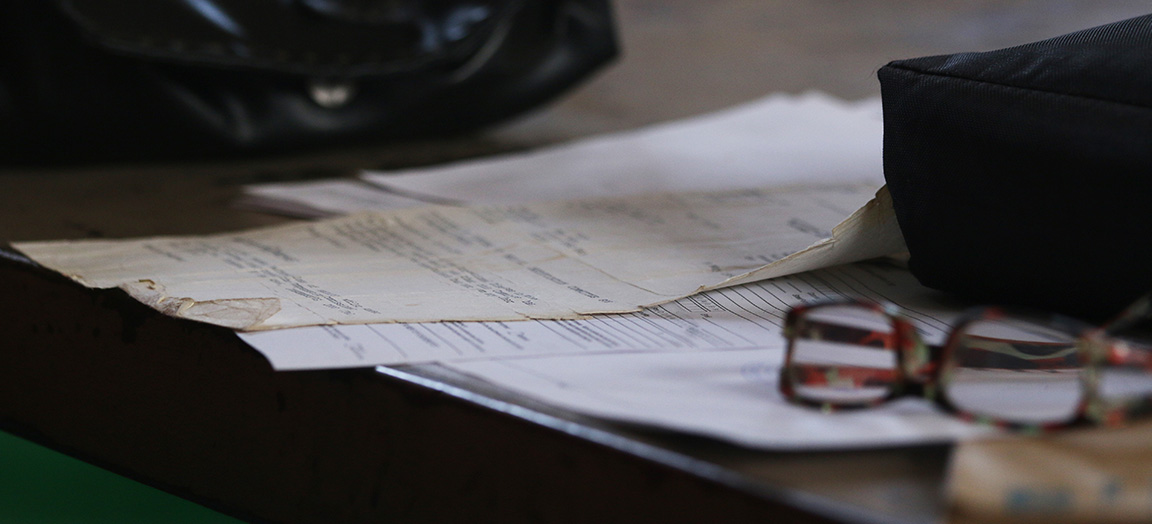
- II -
Hidden lies
U ntil 1994, the South African mining industry was considered one of the safest in terms of disease prevention. But according to McCulloch, there’s a strong link between the transition to democracy under the ANC in 1994 and an increase in incidents of silicosis among black workers being reported.
In 1916, the disease rate of silicosis among black miners was documented at 0.129 percent. It reflected much higher for white miners, at 2.195 percent. The mine’s explanation for this discrepancy was that, since the black migrant miners were working on a contract basis, they had less overall exposure to the dust.
But in the post 1994 new democracy in South Africa, the rate among black miners shot up exponentially, from less than one percent to 25 percent, even though the methods for diagnosing silicosis and tuberculosis did not substantially change between 1916 and 1994.
“Rather than any recent dramatic increase in silicosis and tuberculosis, the discrepancy between the past and current data is due to a systematic under-reporting of cases, which stretches back almost a century,” said McCulloch.
Though the migrant labor system wasn’t a creation of the mining companies themselves, it became the perfect means for exploiting cheap and dangerous labour, and hiding the consequences.
But in the post 1994 new democracy in South Africa, the rate among black miners shot up exponentially, from less than one percent to 25 percent
Up until now, the difficulty of detection of silicosis has allowed the misrepresentation of tens of thousands of deaths – which is what makes the class action so challenging. The diagnosis requires advanced medical skills in occupational diseases and the use of special medical equipment. So plenty of mineworkers were certified with other causes of death, or even as a result of natural causes.
An analysis of the official data provided by StatsSA reveals that only 274 people were reported to have died from silicosis between 1997 and 2015. However, the current estimation of people thought to have the disease at a single mining company today is almost equal to that. This suggests a huge inconsistency and a lack of accuracy in the recording of the causes of death of miners over a period of nearly two decades.
These numbers are at odds with research done by the National Health Laboratory System (NHLS), which states that, in 2013 alone, the overall rate of silicosis contracted by gold miners was at 23%, with a much higher figure for black miners, at 37%.
“The statistics show that the whole story is a joke, the system does not work,” said Spoor, adding that his team had “enormous” difficulties getting hold of the data. According to him, the Employment Bureau of Africa is not willing to provide the information they require.
Dr Gill Nelson of the Division of Epidemiology at the University of the Witwatersrand, has analysed the NHLS data and said it clearly shows the difference in silicosis rates between black and white miners. While the proportion of black miners with silicosis increased from 3% in 1975 to 32% in 2007, the rate of white miners with silicosis only increased slightly, from 18% to 22%.
Nelson highlighted the possibility of an underestimation of the proportion of black miners with silicosis, due in part to the fact that they were not all aware of their right to an autopsy.
What further muddies the waters when diagnosing miners and getting the appropriate certification is the literal definition of silicosis within the compensation legislation. Spoor, who has been challenging this definition, said that to be diagnosed with a compensable disease a miner must have a lung function impediment of more than 10 percent.
“What has been happening is that people are being recognized for suffering from lung disease from silicosis, but their claims are rejected,” said Spoor. “They are not certified to be suffering from compensational disease, because they haven’t met the 10 percent threshold.”
Another complication regarding compensation disbursement is that, in many cases, while miners would be diagnosed with underlying silicosis, they would be incorrectly recorded as dying from tuberculosis.
“Even if your death certificate were correctly recorded with an underlying cause, there’s still a high chance that silicosis would have been missed,” said Ehrlich.
Such was the case for Albert Mvuka, whose death certificate reads “natural causes.” But when he died his widow described how his body was riddled with the effects of TB and silicosis. She described him as “pitch black and extremely thin”, with a significantly impacted ability to breathe.
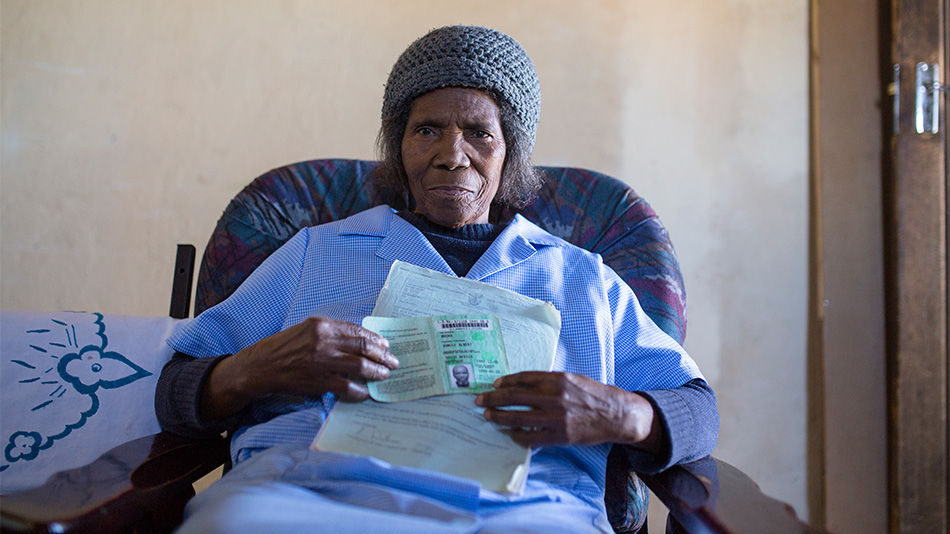
Certified in 1996, Mvuka worked underground for Harmony Gold mining company for 17 years, and only managed to stay alive for a third of that time once he left.
Despite what his death certificate says, when he parted ways with Harmony, Mvuka was given a medical certificate that would later prove his actual cause of death - silicosis - and promised R77,000 in compensation, to be paid out in quotas.
“If any person in Europe died from silicosis or cancer caused by radiation or inhalation of toxic gases, that is not considered a natural death,” said Spoor. “But in South Africa we’ve developed this culture where these [miners] deaths are ‘natural deaths’.”
That was the case for many mineworkers throughout the past century. If, during their annual medical examination they showed any signs of silicosis, they would immediately be retrenched and sent home.
“If you were in a rural area and you were a black person, the chances of you having anything written other than natural causes on your death certificate were probably low,” said Ehrlich.
According to him, at almost every level, the odds were overwhelmingly stacked against ever obtaining a proper diagnosis as a black miner.
If you were a black miner, the chances of having anything written other than ‘natural causes’ on your death certificate were probably low

- III -
A need for education
W hile the rate of accurate diagnoses of both black and white miners has improved in the past decade, the education of black miners – about the implications of silicosis – is still an issue.
For a long time, South Africa was hailed as having the first occupational compensation system for mine workers. What wasn’t commonly talked about, however, was how this system was designed by white unions, and largely reserved for white mine workers alone. Even to this day, the concept of being compensated for any contracted occupational illnesses is one that is heavily entrenched in white culture. It is not the same for black workers.
The Occupational Diseases in Mines and Works Act of 1973 guaranteed miners access to an autopsy, regardless of their cause of death, in order to establish if compensation was due. While approximately 80% of white workers signed up for this option, very few black mine workers ever did or have.
The diagnosis is determined by the NHLS and the results recorded in the Pathology Automation system. An autopsy can detect silica-related diseases where X-rays can’t.
For 2014, the silicosis rate among black gold miners was 297 out of 1000. Autopsies done since 2010 reveal that the majority of miners who exercised this particular right worked for Harmony, Vaal Reef and Beatrix Gold.
Rodney Ehrlich, the epidemiologist from UCT, recalled how his black patients at the clinic for ex-miners at Groote Schuur hospital in Cape Town were often unclear about what they were being treated for – and how this fitted into government’s failure to make compensation and autopsy services more readily available to black miners.
Unlike white miners, Ehrlich said black miners usually weren’t able to distinguish between silicosis and tuberculosis, nor were they educated about the compensation system and what they were due if they got sick on the mines.
Black miners weren’t educated about the compensation system or what they were due if they got sick on the mines
“[Black workers] were never really inducted into understanding the system. They knew there was some payout if you got tuberculosis,” he explained. “But a distinction was never made between silicosis and TB. “It’s a failure of education, but also acculturation — and the roots go back quite deeply to the migrant labour system, the dependence on these jobs.”
Mr. Vuyani Dwadube began working on the mines in 1979 and was retrenched after 16 years of service. Now, he struggles to tell his story without being interrupted by fits of coughing.
His wife Patricia often steps in to fill the gaps in his account. Mr. Vuyani Dwadube says that he was first diagnosed with silicosis in 1993, but Patricia quickly corrects him, saying that he was in fact diagnosed with tuberculosis on three separate occasions.
“After he left the mine the only money that he received after retrenchment was R19,000. But within a year it was finished,” said Patricia.
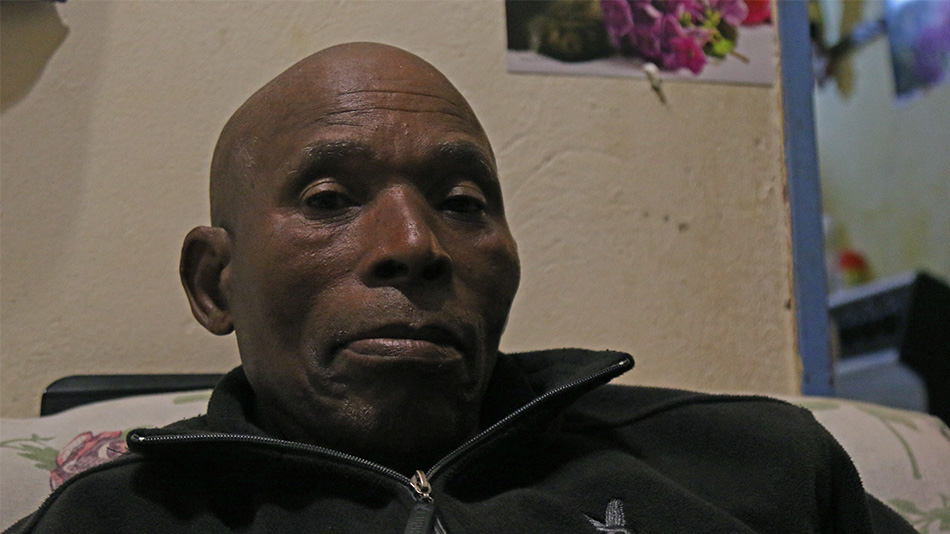
It was difficult for them to support their three children, she said, especially after she was forced to quit her job as a domestic worker so that she could take care of her husband.
“I have to borrow the wheelbarrow and ‘drive’ him to the clinic so that they can see that he is still alive,” Patricia said. He was treated at a government-sponsored hospital, so the tuberculosis treatment was covered, but Patricia was forced to travel long distances to get her husband’s medication.
“He never got any [more] compensation from them. Even today, he’s still waiting for that money he never received,” she said.
“He’s still waiting for that money he never received”
Muriel Mafoyane Masupa is a community organizer in Welkom who has been working with Charles Abraham’s law firm for the past few years. She helps reach out to potential new clients, while also supporting the established ones by telling them which certificates and documents they require in order to be included in the class action.
“The people here, they are still very confused,” said Masupa.
She is a petite, proud woman who speaks passionately about the men she represents. She meets with them, and a small group of other volunteers, at the local rec center in Virginia every third Sunday of the month, where she frequently registers new claimants.
“There is a need for them to be educated about this silicosis thing. They have the right to fight for their rights from the mining house,” she said.
On that particular Sunday, Masupa and the group of community volunteers signed up three new claimants. Last month, they signed up two.
“There are a lot of people (affected),” she said. “Not only here in Virginia or in Welkom but all over South Africa.”
No one has been able to put a firm count on the number of miners who are believed to have been robbed of their dues, but even the conservative estimate puts it at nearly half a million.
“We do have a database of about 40,000 people, but that is not a representative database – that is just the people who have registered claims,” said Spoor, adding that a lot of sick miners simply haven’t been properly documented at all.
Although there are claims against over 90 mining companies, the majority point to Vaal Reefs Gold Mine Shaft (3479 claims); Harmony Gold Mine (3222); Driefontein Gold Mine (2439); President Steyn Mine (2329) Kloof Gold Mine (2215) and President Brand Mine (1826).
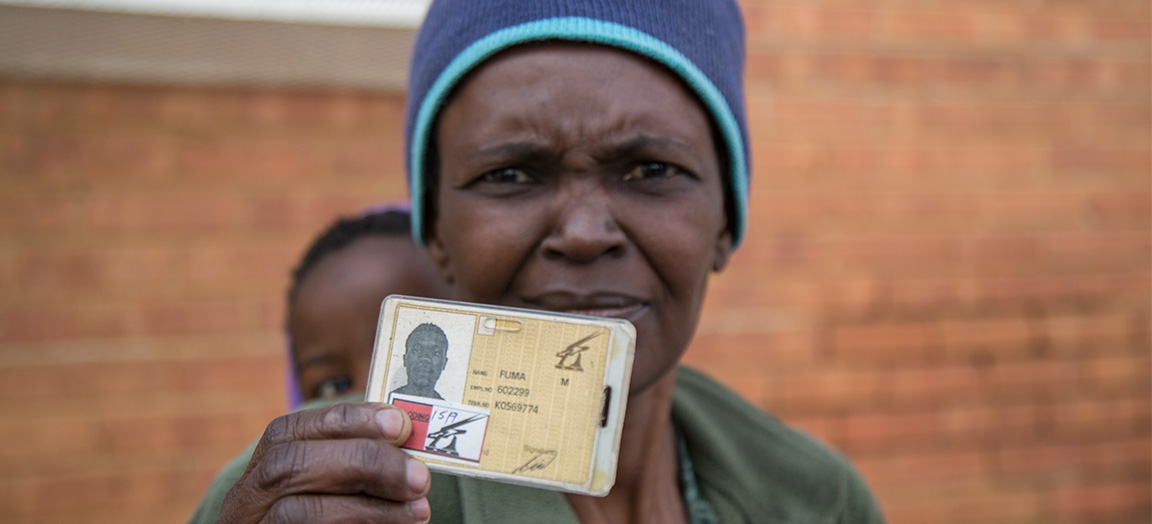
- IV -
Suffocation by red tape
M a’Lerato Beatrice’s husband was diagnosed with both silicosis and tuberculosis decades ago. Mathi Paulos continued working on the dusty mines of Virginia after diagnosis, and eventually died there in 2003.
“He was [supposed to be] compensated for silicosis. And after being compensated, he died,” said Beatrice. Today, she has a granddaughter wrapped snugly onto her back. But when her husband died her three children were all very young.
“After he died, I didn’t get the full amount,” she said. “Only 10 percent.”
The issue of transferability, that is, having compensation for illness transferred over to deceased miner’s wives and families, is only one section of the current litigation that the six main gold companies that make up the Occupational Lung Disease Working Group are petitioning against in the Supreme Court of Appeal. The other two sections they are opposing are the certification of the silicosis case, as well as the certification of the tuberculosis case.
“This thing can easily be dragged out to a series of appeals for another year to 18 months. I don’t think that would be difficult at all,” said Spoor, who has already been working on the certification issue since 2012.
“The mining firms could find reasons as to why they are seeking to appeal until the cows come home,” he said, as it would likely work out cheaper for them to be in court for the next 15 years than it would be to compensate all of the claimants.
“It would likely work out cheaper for them [mining companies] to be in court for the next 15 years than it would be to compensate all of the claimants”
One estimate cited by Reuters says that the total claim, erring on the conservative side, would be close to $3.25 billion.
Another reason for delaying is related to the issue of his clients’ age, Spoor said.
“Our clients are mainly elderly people who are sick and dying – and the longer the matter delays, the fewer claims there are and the more difficult it becomes to prove your damages,” said Spoor, adding that an estimated four percent of their clients are dying each year.
“This litigation has been going now for 10 years and in that time, perhaps as many as a half of former gold mine workers with silicosis have probably died.”
Delaying by appealing is considered a very effective negotiating strategy.
“We are under a lot of pressure to conclude a settlement in the interest of our clients because they are dying,” Spoor said. “We are not afraid to make compromises, but as you can imagine these are difficult negotiations.”
In response to a request for comment on its knowledge from previous decades of the potential harm of gold mining on miners, the Chamber of Mines responded in an email that “the leaders of the mining industry today acknowledge their industry’s negative legacies, including in respect of occupational health.”
When pressed further about the current appeals, the Chamber responded by quoting a press release from the Chamber’s president, Mike Teke, during his Annual General Meeting address earlier in the year:
“…Our gold companies are seeking to find fair and sustainable solutions to the challenges of silicosis. And the Chamber’s health team is doing excellent work to address the excessive incidences of TB on the mines and in mining towns. What we are doing, though, is working towards achieving what should always have been the norm.”
“‘Did they know? The only answer to that is, if they didn’t know they were absolutely stupid,” said McCulloch’.”
Both Spoor and McCulloch, who have dedicated years of their lives to uncovering the scope and extent of the silicosis scourge, agree that there is not a doubt in their minds that the Chamber knew exactly what risks they were subjecting miners to.
“Did they know? The only answer to that is, if they didn’t know they were absolutely stupid,” said McCulloch, who through his years of research has never seen any evidence to support the theory that it was a mere oversight.
“The committees in the Chamber knew with absolute surety what was happening. I’ve got no doubt whatsoever”
The lawyers, the researchers, campaign organizers and the miners all agree that it’s high time the mines paid their dues.
“I think in the case of South Africa, the lifeline of the mines was cheap black labour,” said McCulloch, reflecting on his years of research. “And so in a way, that’s the hinge in which this whole story revolves. And that’s the centerpiece. It was just that the industry wasn’t paying its own way. It wasn’t paying for the cost of production.”
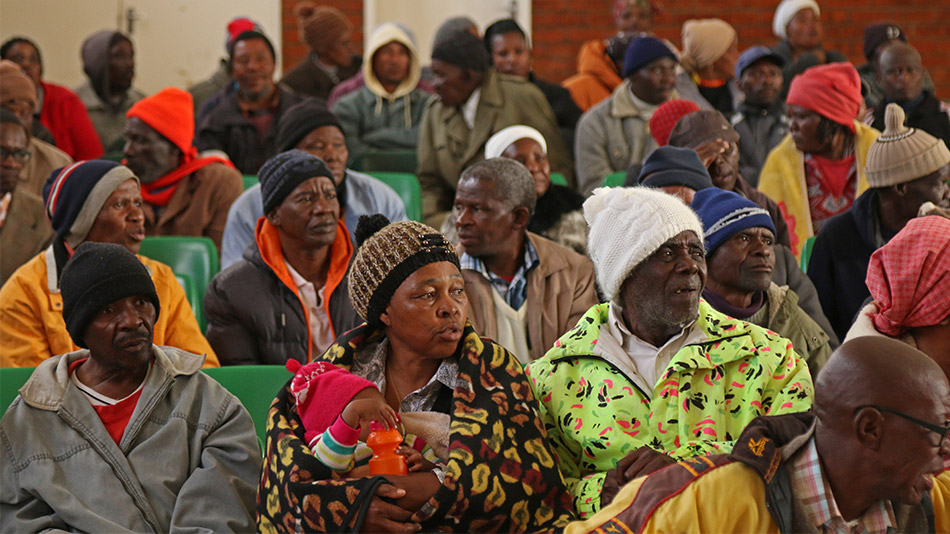
On an August day in 2016 in Welkom, a blurry-eyed ex-mine worker named Alfred Sitoe gave his account of his years underground. He began working on the mines in 1946, and became one of the first claimants to join the silicosis class action.
“To this day, I have only received R3097,” said Sitoe.
Born in 1918, he’s 98 years old this year. He walks with difficulty. He needs to be supported on either side to shuffle the couple of blocks from his house to the rec center, but he still makes it to the claimant meetings.
So far, that monthly 200-metre struggle has got him nowhere – and it’s unlikely he’ll see the end of this journey to justice before he is laid down at home to die.

